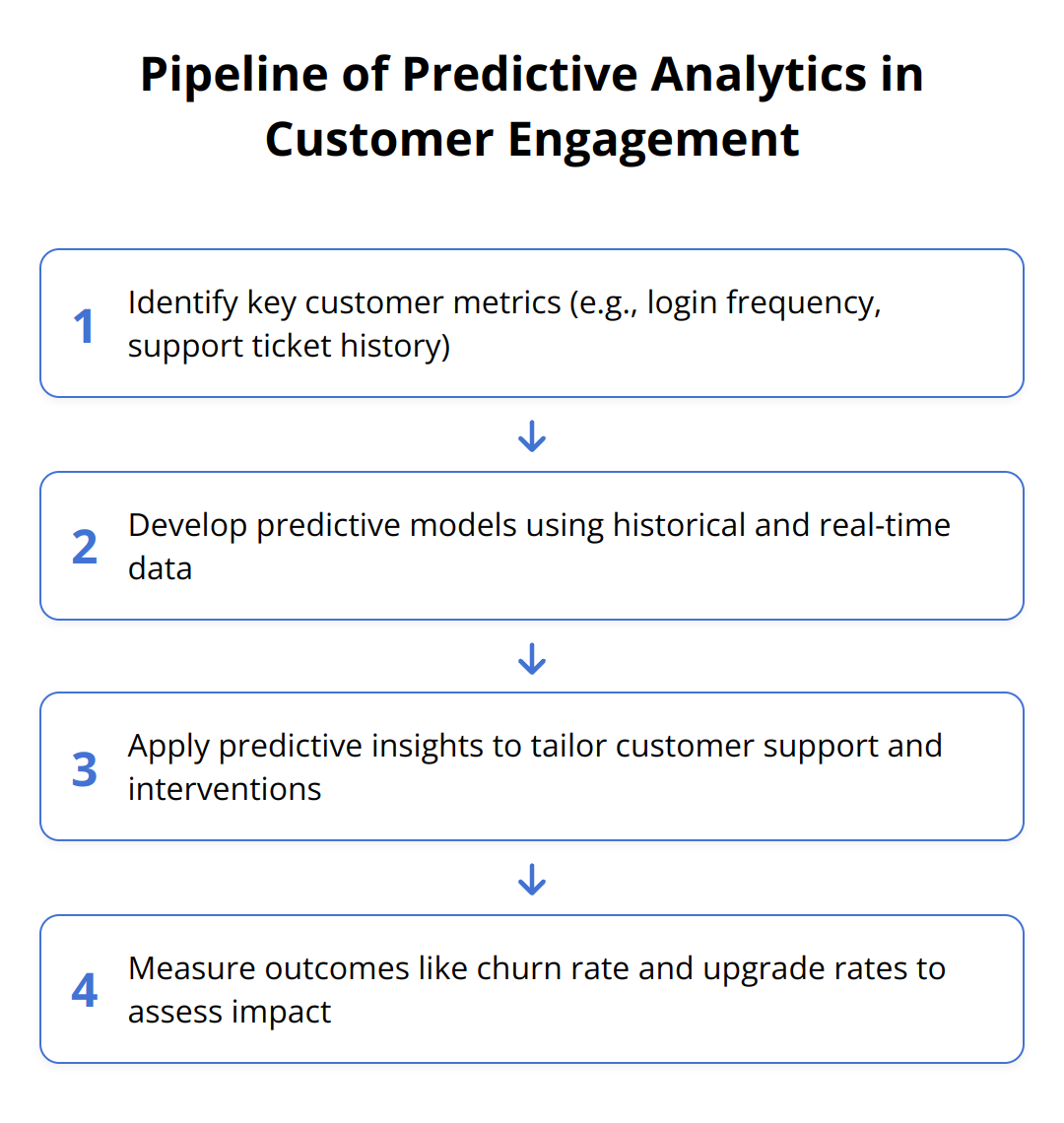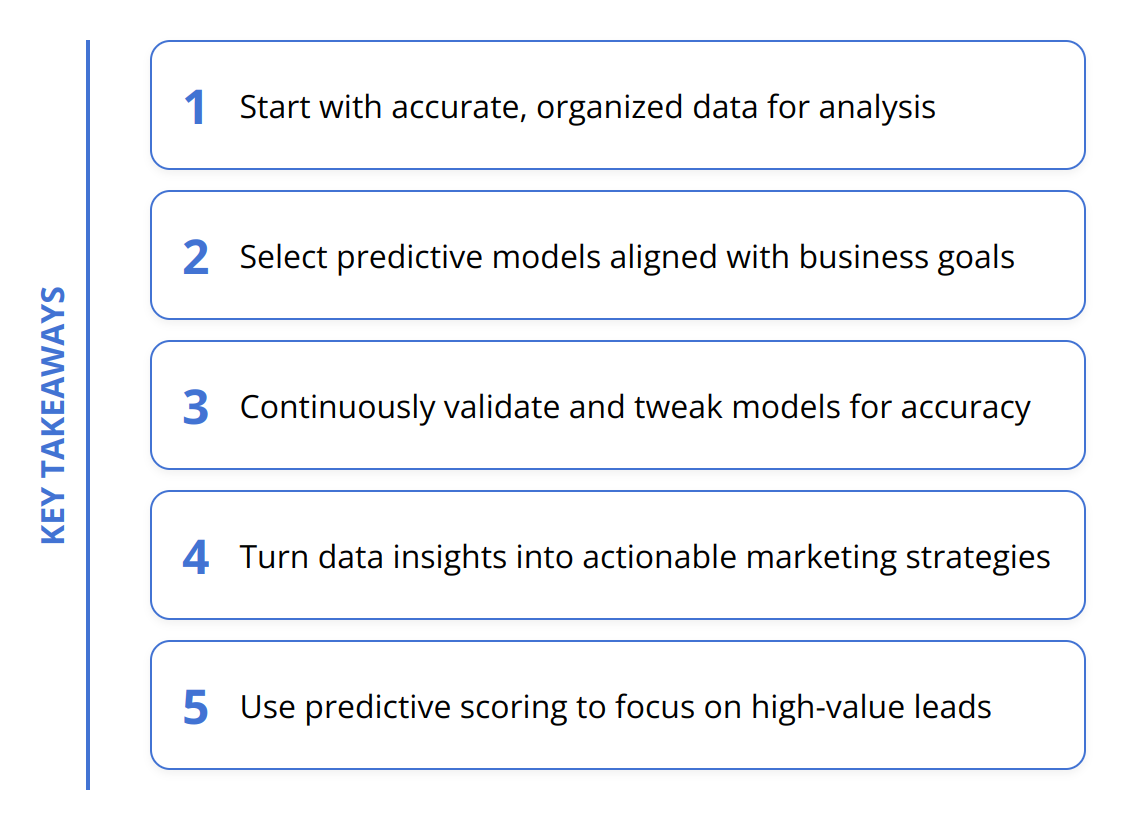Predictive analytics is transforming the way B2B companies operate, turning vast data landscapes into actionable business insights. We at Emplibot recognize the power it holds to reshape strategies from lead scoring to supply chain management.
This blog post will explore how predictive analytics is applied in B2B environments, highlighting its benefits and offering a glimpse into its real-world applications. By the end, B2B professionals will have a clearer understanding of how this technology can be leveraged to drive their business forward.
Harnessing B2B Predictive Analytics
The game-changer in today’s B2B landscape is undeniably predictive analytics. At its core, this approach involves scrutinizing historical and current data to make educated forecasts about future trends and customer behaviors. It goes beyond mere number-crunching; predictive analytics in B2B settings is about foresight—steering business decisions with a forward-looking radar.
Data: The Fuel for Predictive Analytics
For predictive analytics to provide any value in a B2B context, it hinges completely on the quality and depth of data. The more comprehensive your data set, the sharper your predictive insights will be. Companies need to invest in robust data collection and management systems. But it’s not just about collecting data; it’s about collecting the right data. B2B companies must become surgical in their approach, pinpointing variables that align closely with business outcomes, such as customer lifetime value or purchasing patterns.

Predictive Models: The Heart of the Operation
When it comes to predictive analytics in B2B, there’s a spectrum of models at play. Regression models can forecast customer spend, while classification models might predict whether a new lead is likely to convert into a sale. More advanced techniques include time series forecasting for market trends, and survival analysis for customer churn rates.

Practical Steps to Implement B2B Predictive Analytics
-
Start clean: Ensure your data is accurate and organized before feeding it into any analytical model.
-
Choose wisely: Not all models are created equal. Select a model that aligns with your specific business goals.
-
Test and refine: Continually validate your models against real-world outcomes and tweak them for better accuracy.
-
Think integration: Embed predictive analytics deeply into your business processes for maximum impact.
Business leaders who harness predictive analytics effectively gain a competitive edge. Armed with foresight, they can allocate resources more efficiently, anticipate market changes, and personalize customer interactions to a degree that was previously out of reach.
From Data to Strategy: How to Make the Shift
Shifting from a reactive to a proactive stance in B2B marketing requires more than just recognizing the importance of predictive analytics. Marketers must translate data insights into actionable strategy. This means recalibrating marketing efforts based on predictive findings to enhance engagement, optimize funnel conversions, and drive revenue growth.
Transforming hard data into strategic action can be an uphill battle, but practical steps include:
-
Developing a clear, data-backed customer journey and aligning marketing content to each stage.
-
Identifying high-value leads through predictive scoring to focus sales efforts.
-
Adjusting pricing strategies in anticipation of market shifts.
-
Crafting targeted campaigns that speak to predicted customer needs.
By integrating predictive analytics into daily operations, B2B companies can make informed, strategic decisions that not only respond to current market conditions but also anticipate future developments.
For those eager to explore the nuances of predictive analytics in marketing efforts, our blog provides a comprehensive guide on predictive analytics in marketing, which further delves into models and actionable insights. Another valuable resource is our take on B2B marketing automation trends that includes the intersection of automation and predictive insights.
Remember the framework – good data and carefully chosen models lead to sharper predictive insights, propelling B2B companies ahead of the curve. Use them, and you’ll be ready not just for the marketplace of today, but for the challenges and opportunities of tomorrow.
Now let’s look at how to take these insights and put them into action through concrete strategies and applications.
Boosting B2B Results with Predictive Analytics
The competitive edge in business today often hinges on how well a company anticipates the future and takes proactive steps. In the realm of B2B, predictive analytics has become a pivotal tool in forecasting trends, understanding customer behavior, and ultimately driving strategy. Here’s how businesses are riding the wave of analytics to forge ahead and streamline their operations.

Sharpening Lead Scoring for Precision Sales
Sales teams equipped with predictive lead scoring can focus on high-intent prospects with a greater likelihood of conversion, saving time and resources. By analyzing past interactions and outcomes, businesses can rank leads based on their potential value and probability of closing a deal. This precise targeting not merely boosts sales efforts but results in efficient resource allocation and higher conversion rates.

For instance, a company might review historical data on lead response times and content engagement to identify characteristics shared by converted leads. This information can then power algorithms to flag similar prospects, directing sales teams to engage with the right leads at the right time. When sales reps know who is most likely to buy, they can personalize their approach, leading to an enhanced buyer experience and better sales outcomes. An invaluable resource for those diving into the specifics of predictive lead scoring is our detailed article on AI-powered sales predictions.
Enhancing Lifetime Value Forecasts
Businesses that track and act on Customer Lifetime Value (CLV) metrics stay strides ahead in the marathon for long-term profitability. Predictive analytics can unravel patterns in customer behavior, enabling companies to anticipate who will become their most valuable clients over time. With this foresight, businesses can tailor retention strategies, maximize up-sell and cross-sell opportunities, and allocate marketing budgets with precision.
Knowing a customer’s future worth helps in identifying the right incentives and engagement strategies. For example, data showing a segment of customers who increase spending when offered educational resources can prompt the creation of targeted content campaigns, ensuring longer and more fruitful customer relationships.
Streamlining Supply Chains
Predictive analytics unlocks efficiencies in inventory management and supply chain logistics by leveraging insights into demand forecasts. By recognizing the signs that predict spikes in demand or supply shortages, companies can optimize stock levels, reducing both excess inventory and stockouts. It’s not just about responding to the market demand; it’s also about predicting it.
Predictive analytics can answer questions such as: Which products will be in high demand next quarter? What impact could a change in supplier lead times have on our inventory levels? How might economic shifts affect our supply chain? By analyzing past data and external factors, companies can create robust models to maintain the right inventory balance and manage their supply chain with agility.
In conclusion, the power of predictive analytics isn’t in its complexity or the volume of data it can process. It’s in its ability to cut through the noise and provide targeted, actionable insights. Businesses wielding this tool effectively can experience enhanced lead prioritization, more accurate lifetime value projections, and a finely tuned supply chain.
The key is to start with a clear strategy, leverage high-quality data, and keep refining your models to ensure they stay relevant and accurate. Consider exploring our insights on predictive customer segmentation to further understand how predictive analytics can fine-tune your customer understanding.
As we continue to navigate through the intricacies of predictive analytics, we can look forward to even more innovative applications in the B2B sphere, from personalized marketing to strategic planning and beyond.
Predictive Analytics in Action for B2B
When B2B companies incorporate predictive analytics into their operations, what emerges are not just predictions but a roadmap for future success. Let’s talk about how these analytics are working wonders in three specific sectors: SaaS Customer Success, B2B Finance, and Manufacturing.
In the realm of Software as a Service (SaaS), customer success is paramount. The ability to predict which customers are likely to churn or upgrade their services is gold. A SaaS provider can look at usage patterns, support ticket history, and customer feedback to predict customer needs proactively. By doing this, they improve retention rates. One example is a company that developed a prediction model to identify at-risk customers. They used factors such as login frequency and feature usage. By intervening early with targeted support, they cut churn rates by half, demonstrating that predictive analytics can be a lifesaver when wielded correctly.
Turning to B2B finance, risk assessment is a hot topic. Companies here can leverage predictive analytics to evaluate the credit risk of potential borrowers. They use a mix of historical data, market trends, and company-specific financials. One financial institution used a model that incorporated real-time economic indicators alongside customer transaction data, which improved their loan default predictions by a significant margin. This approach reduced bad debt and optimized credit offerings. Numbers don’t lie; organizations that use analytics to assess risk can decrease loan defaults by an edge as sharp as 25% over those that don’t.
In the manufacturing sector, demand forecasting demands attention. Companies employ predictive models to forecast product demand, adapting production schedules and inventory accordingly. One manufacturer of electronic components utilized seasonal sales data, competitor pricing, and economic indicators in their predictive models. This tailored approach led to a 15% reduction in inventory costs and an uplift in customer satisfaction due to better availability. With numbers like these, it’s evident that the predictive approach refines operational efficiency in manufacturing.
Here’s why these examples stand out:
-
They focus on specific measurements that directly impact business outcomes, such as churn rate or inventory costs.
-
The companies used historical and real-time data to feed their models, ensuring a rich dataset for analysis.
-
Predictions were closely aligned with business objectives, leading to targeted strategies and measurable results.

For B2B professionals exploring the potential of predictive analytics in customer engagement strategies, a visit to our insights on customer data platforms can unlock useful knowledge and techniques.
Predictive analytics is no longer just a buzzword; it’s a powerful tool that’s redefining the B2B landscape. By turning data into proactive strategies, companies are not only solving today’s challenges but are also setting the stage for tomorrow’s opportunities.
Final Thoughts
We’ve journeyed through the landscape of B2B predictive analytics, witnessing its ability to transform data into strategic gold. The impact it has on decision-making, sales optimization, and operational efficiency is undeniable. Businesses can predict customer behaviors, refine marketing strategies, and advance confidently into the future. We at Emplibot have seen businesses flourish as they embrace this technology to secure a competitive edge in their respective markets.

Key takeaways highlight the profound influence of predictive analytics:
-
Sharpen decision-making with data-driven insights
-
Optimize sales efforts with predictive lead scoring
-
Boost long-term profitability through enhanced customer lifetime value forecasts
-
Achieve operational excellence with improved supply chain management
Looks toward the future point to an era where predictive analytics becomes tightly woven into the business fabric. Precision marketing, AI-driven customer service, and relentless innovation in data analysis methods will likely set the bar. This holds particularly true as businesses strive for hyper-personalization and agility in navigating the shifting demands of the B2B world.
To stay ahead, B2B entities need to welcome the evolution predictive analytics offers. Stepping into this arena means differentiating your services, anticipating client needs, and forging stronger, long-lasting business relationships. The value in harnessing this technology is well-proven, and it’s poised to shape the B2B markets for years to come.
For those on the brink of adopting predictive analytics or looking to streamline their online content strategy, exploring Emplibot solutions is a significant first step. We offer an innovative approach to automatically publish SEO-friendly content on your WordPress site, designed to enhance your digital presence effortlessly.
The potential of predictive analytics in B2B is vast and the time to act is now. Embrace the data, unlock the insights, and let foresight guide your business strategy. Discover more on how automation and analytics intersect on our blog to start this transformative journey with a full set of tools at your disposal.
The innovative power of predictive analytics is here. It’s ready to bolster your B2B operations and propel growth as never before. It’s not just about competing; it’s about leading the way.

